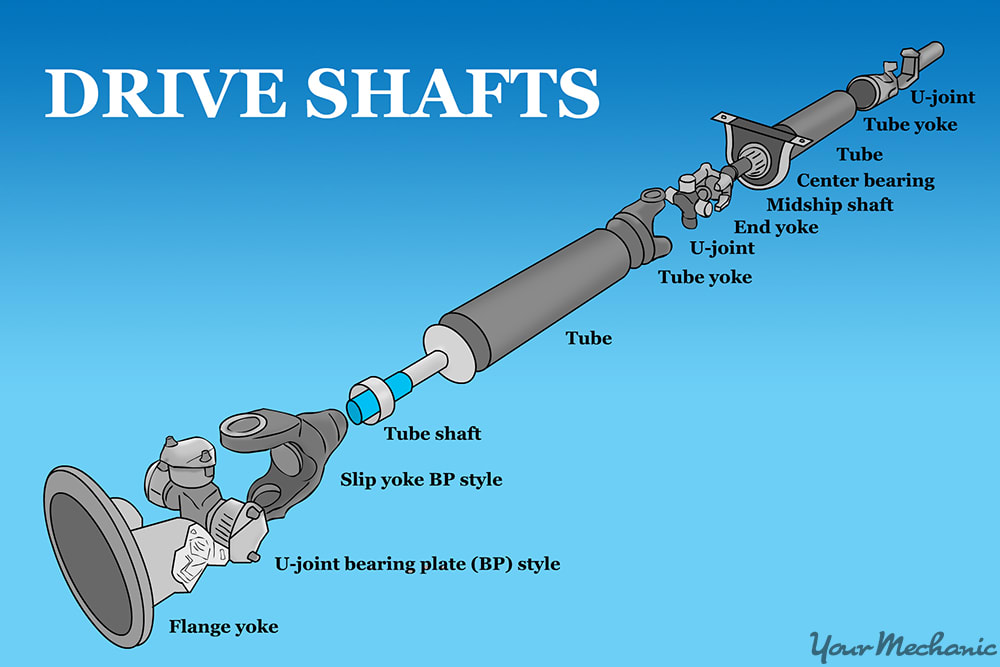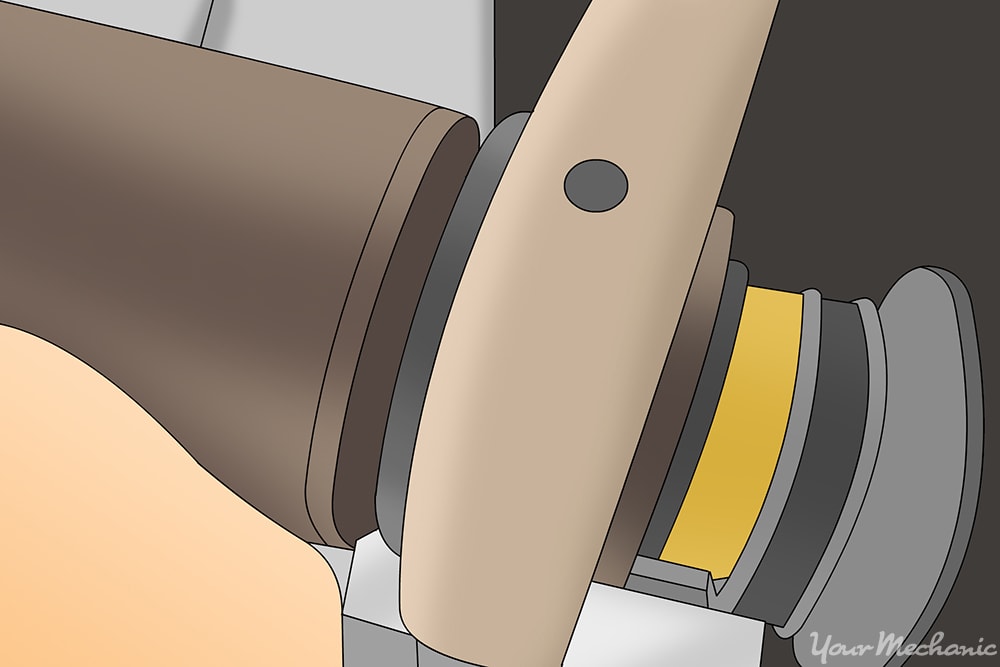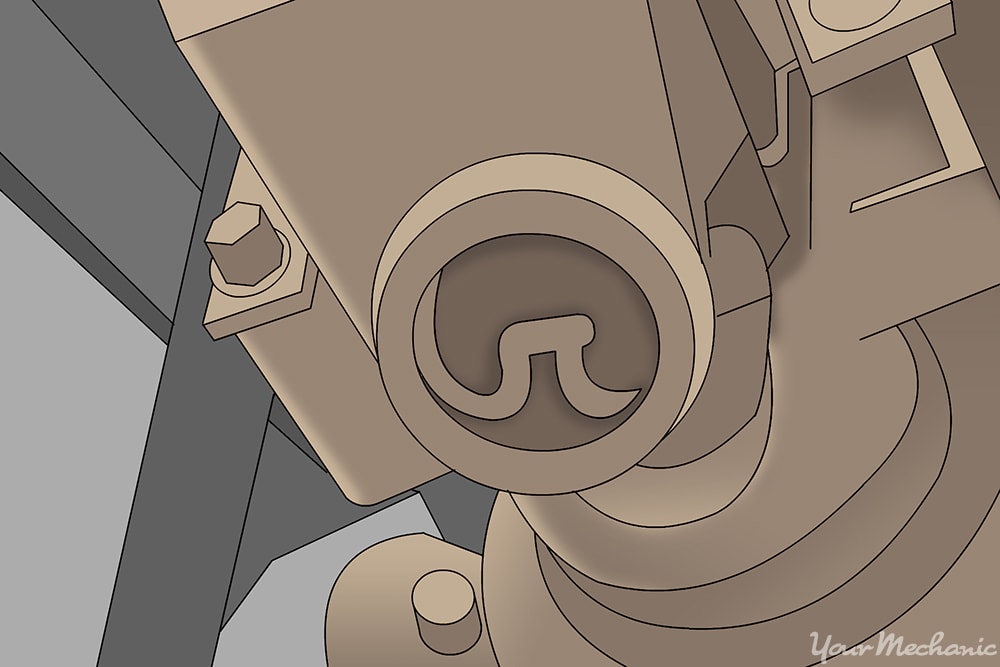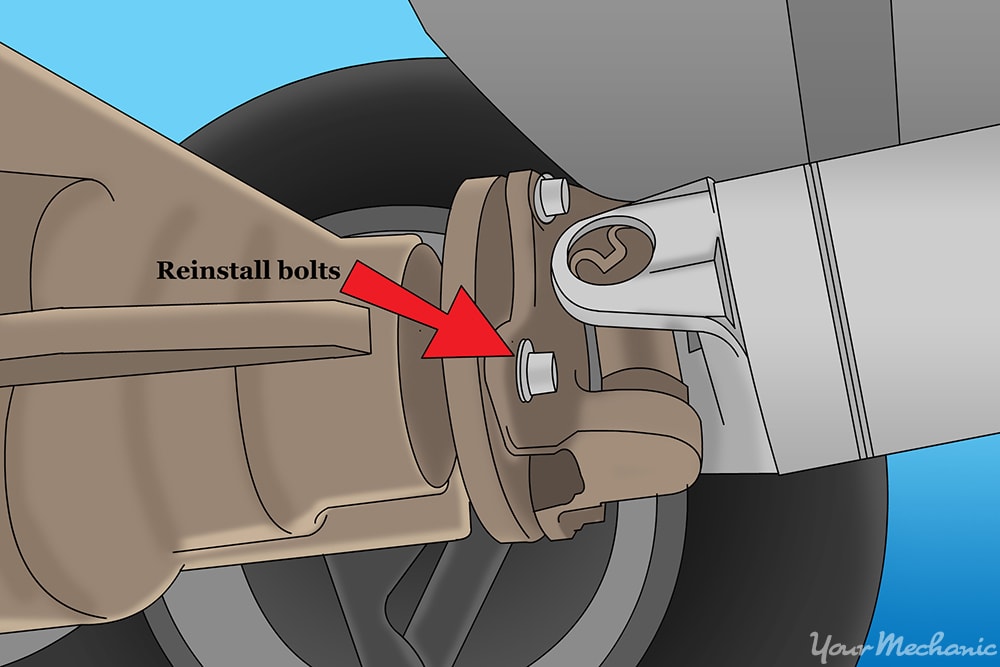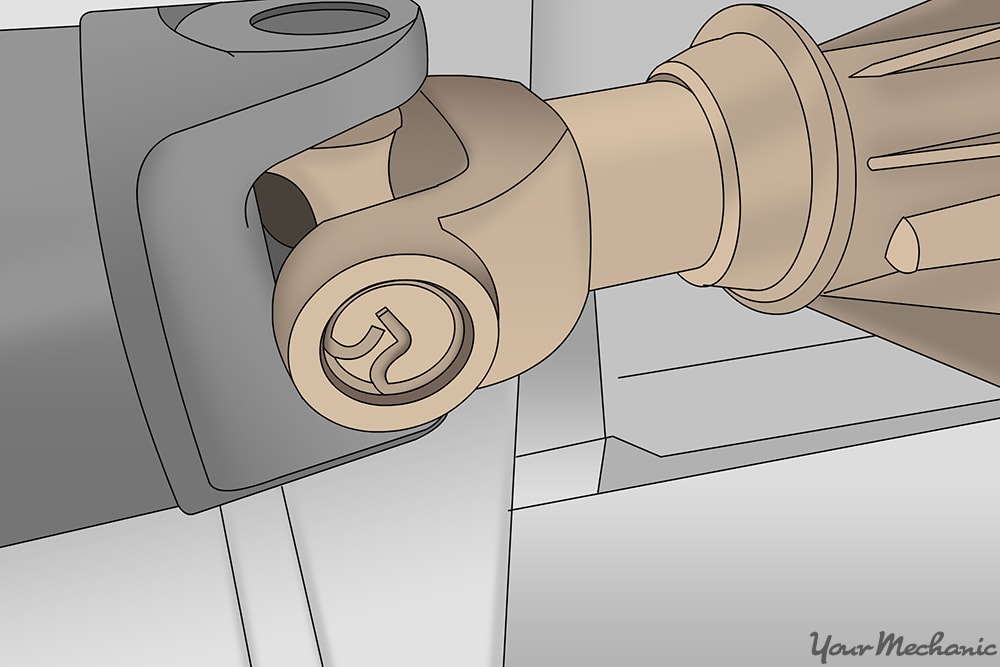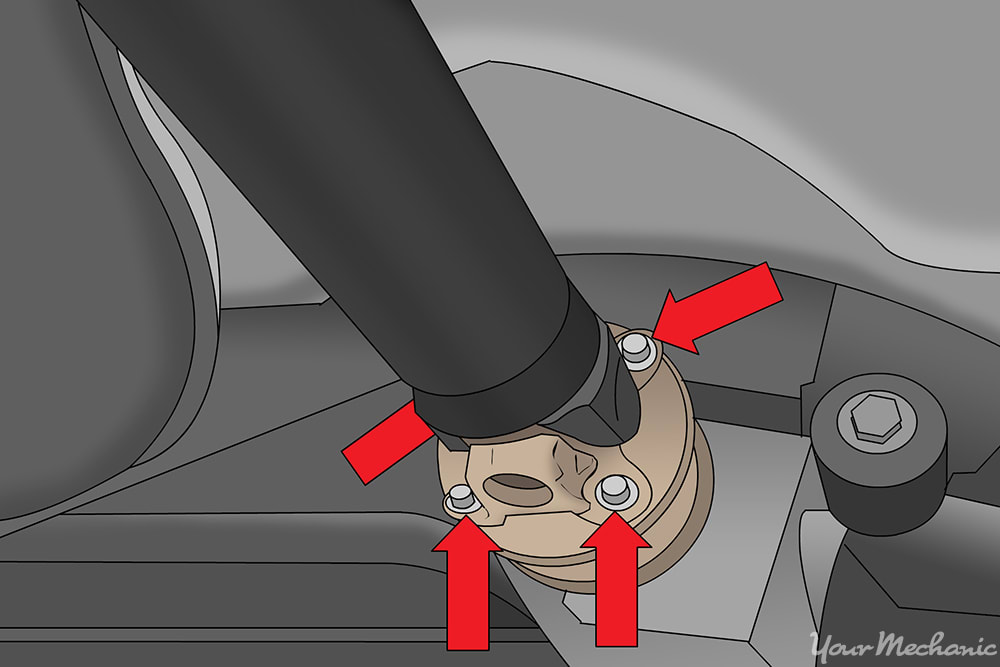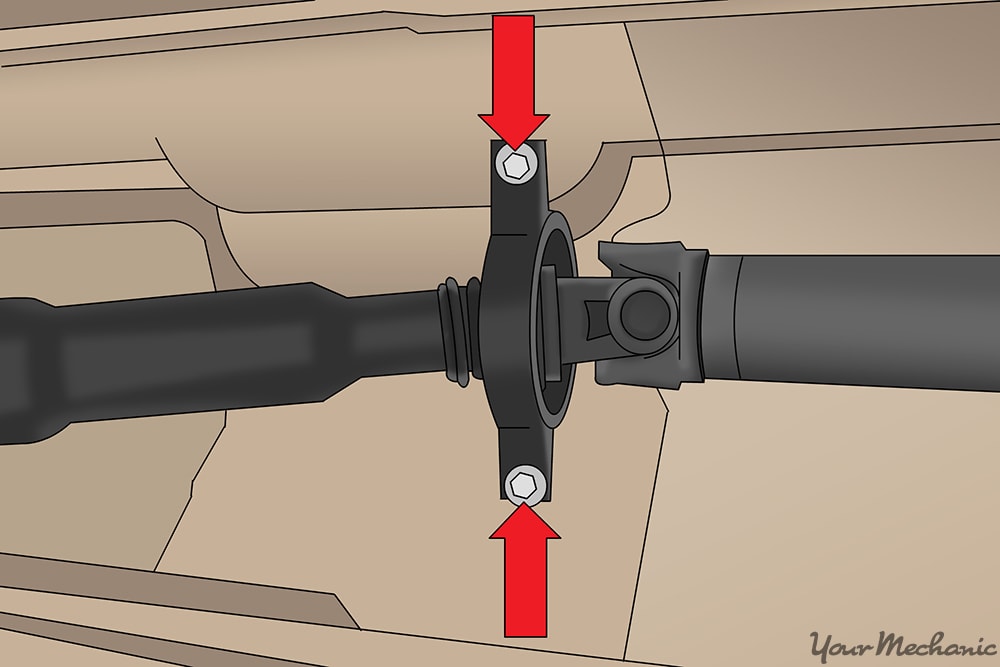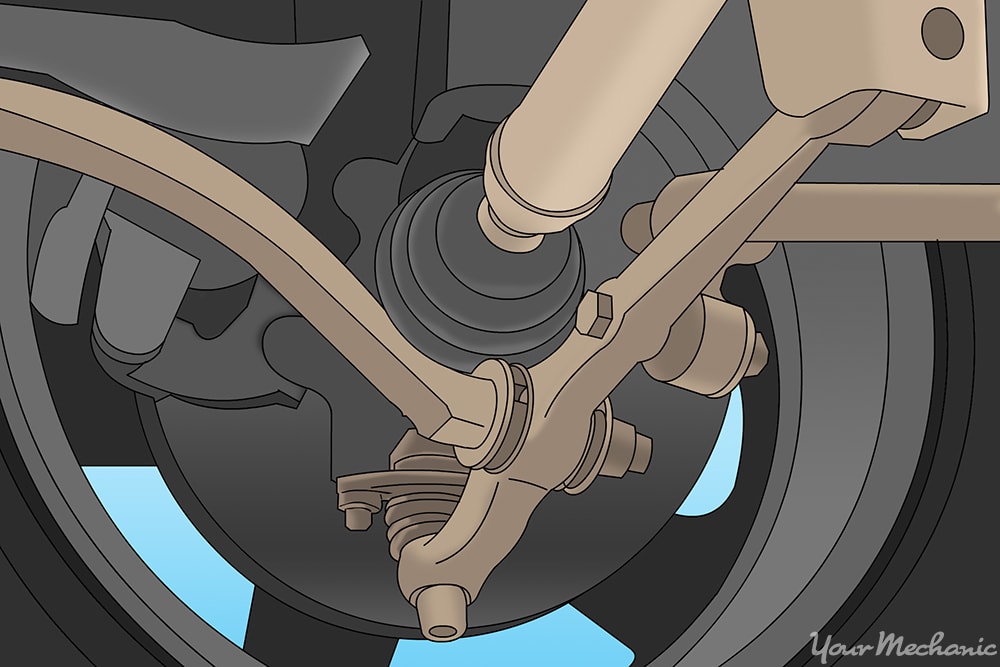

The driveshaft of a rear wheel or four-wheel drive vehicle is carefully assembled, precision balanced component that supplies power from the transmission to the rear center gears and then to each rear tire and wheel. Connecting the two sections of the driveshaft is a center support bearing, which is a "U" shaped metal bracket with a solid-rubber machined bearing on the inside. The bearing is designed to keep both parts of the driveshaft solid in order to reduce harmonic vibration as the vehicle accelerates.
Although its design and purpose is incredibly simplistic in nature, replacing a driveshaft center support bearing is not one of the easiest jobs to complete. The main reason why many DIY mechanics struggle with driveshaft center support replacement due to the details involved with reassembly of the driveshaft.
- Note: Since all vehicles are unique, it's important to understand that the guidelines and instructions listed below are general instructions. Make sure to verify specific instructions with your vehicle manufacturer service manual before proceeding.
Part 1 of 5: Determining the symptoms of a bad driveshaft center support bearing
The driveshaft is a precision piece that is balanced perfectly before it is installed by the factory. It's also a very heavy piece of equipment. It's recommended not complete this job on your own without the proper tools, experience and support equipment. If you don't feel 100 percent confident about replacing the driveshaft center support bearing, or don't have the recommended tools or help, please contact an ASE certified mechanic to complete this job for you.
A worn out or faulty center support bearing will produce a few symptoms that can alert the driver that a potential problem has occurred and requires replacement. Noted below are a few of these warning signs to look for before you make the decision to replace the driveshaft center support bearing.
Step 1: Check for clunking noises when accelerating or decelerating. The most common sign that is a noticeable "clunking" sound coming from under the vehicle's floorboard.
You'll often hear this when you accelerate or when the vehicle changes gears or during braking. The reason this sound is made is because the inner bearing has worn out and causes the two attached driveshafts to become loose during acceleration and deceleration.
Step 2: Watch for shuddering during acceleration. Another warning indicator is when you feel a shudder on the floor board, the accelerator pedal or the brake pedal as you accelerate or brake.
A failed bearing is unable to support the driveshaft, and as a result the driveshaft will flex, causing a vibration and shuttering sensation that can be felt throughout the vehicle when it's broken.
Part 2 of 5: Physically inspect the driveshaft center support bearing
Once you've properly diagnosed the problem and you're fairly certain that the cause is due to a worn out center support bearing, the next step is to physically inspect the part. This is a critical step where many DIY mechanics and even new ASE certified mechanics tend to skip. Before proceeding, ask yourself this simple question: "Without manually inspecting the part, how can I be 100 percent certain that it's the root cause of the symptoms I'm trying to solve?" With an internal engine component, this is very difficult to do without disassembling the motor. However, the center support bearing is exposed under the vehicle and easy to inspect.
Materials Needed
- Eye protection
- Flashlight
- Gloves
- Piece of chalk or marker
- Roller or creeper if the vehicle is not on a lift
Step 1: Put your gloves and eye protection on. You don't want to start grabbling or handling metal objects without protection for your hands.
The top of the center support bearing may be sharp and cause serious cuts to hands, knuckles and fingers. Plus, there will be a tremendous amount of dirt, grime and debris under your vehicle. Since you'll be looking upward, it's likely that this debris will fall into your eyes. Although it's assumed that blood, sweat, and tears are needed to repair most vehicles, reduce the potential of blood and tears and think safety first.
Step 2: Roll underneath the vehicle to where the center support bearing is located. Once you have the proper safety equipment in place, you'll need to ensure the vehicle is secure on the lift.
Step 3: Locate the front and rear driveshaft(s). Find where these are located on your car.
Step 4: Locate the center attachment where both driveshafts meet. This is the center support bearing housing.
Step 5: Grab the front driveshaft and attempt to "shake it" near the center support bearing. If the drive shaft shakes or appears loose inside the bearing, the center support bearing needs to be replaced.
If the driveshaft is solidly mounted in the bearing, you've got a different problem. Complete the same physical inspection with the rear driveshaft and verify the loose bearing.
Step 6: Mark the alignment of both front and rear driveshaft. The two driveshaft's that attach in the center support bearings are attached on opposite sides of the vehicle as well.
The front drive shaft is attached to the output shaft coming out of the transmission, while the rear driveshaft's propeller shaft is attached to the yoke that comes out of the rear axle differential.
- Warning: As noted above, the driveshaft is carefully balanced and needs to be removed in order to replace the center support bearing. Failure to reattach the driveshaft on front and back, precisely where they came from will result in an unbalanced driveshaft that will vibrate and may cause serious damage to the transmission or rear end gears.
Step 7: Locate where the front driveshaft attaches to the transmission. Using your chalk or marker, draw a solid line directly underneath the transmission output shaft and align that line to a similar line drawn on the front of the driveshaft.
Driveshafts that are connected into a splined shaft on the transmission can only fit in one direction, but it's still recommended to mark both ends for consistency.
Step 8: Make the same reference markings. Locate where the rear driveshaft attaches to the rear end yoke and complete the same reference markings as shown in the image above.
Part 3 of 5: Securing the correct parts and prepare for replacement
After you've correctly determined that the center support bearing is damaged and needs to be replaced, you need to prepare for the replacement. The first thing you should do is secure the right replacement parts, tools and materials that you'll need to complete this job safely and correctly.
Materials Needed
- Jack and jack stands
- WD-40 or other penetrating oil
- Work light
Step 1: Prepare the vehicle for working. Use a floor jack to raise the vehicle to a height that will allow easy access to the driveshaft while using your tools.
Jack one wheel at a time and place jack stands underneath solid mounts for support. Once the vehicle is secured make sure you have enough light to see underneath the vehicle. A work light attached to the front axle or rear axle is a good idea.
Step 2: Lubricate rusty bolts. While you are under the vehicle, take a can of WD-40 and spray a liberal amount of penetrating fluid on each bolt that attaches the driveshaft (the front and rear).
Let the penetrating oil sit for 10 minutes before removing proceeding to next step.
Part 4 of 5: Replace the center support bearing
Materials Needed
- Brass center tap
- Combination wrench set and extensions
- Grease
- Replacement center support bearing
- Replacement clamp
- Rubber or plastic tipped hammer
- Socket wrench set
Work light
Note: Check with manufacturer on recommended grease for bearings on your particular vehicle.
Note: For the replacement center support bearing, be sure to acquire the precise part recommended by the vehicle manufacturer (only replace with the entire housing that includes the outer housing, inner bearing and inner plastic supports).
Warning: Do not attempt to replace inner bearing only.
Tip: There are a lot of people that believe it's possible to remove the center support bearing and reattach it by using a press or other methods. In most cases, this method fails as the bearing is not properly attached or secured. In order to avoid this problem, locate a local machine shop that can remove and install the center support bearing correctly.
Step 1: Remove the front driveshaft. The front driveshaft is attached to the transmission output shaft and connected by four bolts.
On some rear wheel drive vehicles, the bearing block bolts thread into nuts that are solidly mounted or welded onto the frame. On some vehicles, two part nuts and bolts are used to attach the rear of the front driveshaft to the center support bearing.
Step 2: Remove the bolts. Get the correct size end wrench or socket wrench to do this.
Step 3: Remove the front part of the driveshaft. The front driveshaft is going to be attached solid inside the output shaft supports.
In order to remove the driveshaft, you'll need a rubber or plastic tipped hammer. On the front of the driveshaft is a welding mark that is solid and is the best place to hit with the hammer to loosen the driveshaft. Using the hammer and with your other hand supporting the driveshaft from underneath, hit the weld mark solidly. Repeat until the drive shaft is loose and can be removed from the front.
Step 4: Remove the bolts attaching the front driveshaft to the center support bearing. Once the bolts are removed, the front driveshaft will be detached from the center support bearing.
Step 5: Place the front driveshaft in a secure area. This will keep it from being damaged or misplaced.
Step 6: Remove the rear driveshaft. The rear driveshaft is attached to the rear end yoke.
Step 7: Remove the rear driveshaft. Remove the bolts that attach the two components together first; then carefully remove the driveshaft from the yoke using the same method as the front driveshaft.
Step 8: Remove the center clip that attaches the rear driveshaft to the center support bracket. This clip is removed with a straight-edge screwdriver.
Carefully unscrew this and slide behind the rubber boot for future use.
- Warning: If you remove the clamp all the way, it will be very difficult to correctly replace it; which is why it's recommended above to buy a new replacement clamp that you can reinstall to attach the rear driveshaft to the center support bearing.
Step 9: Remove the boot. After you've removed the clamp, slide the boot from the center support bearing.
Step 10: Remove the center support bearing housing. Once you've removed the rear driveshaft, you'll be ready to remove the center housing.
There are two bolts on top of the housing that you'll need to remove. Once both bolts are removed, you'll be able to slide the front driveshaft and rear input shaft easily from the center bearings.
Step 11: Remove the old bearing. The best way to accomplish this step is to have a professional machine shop remove and professionally install the new bearing.
They have access to better tools that allow them to complete this job easily than most DIY mechanics. Listed below are the steps to follow if you don't have access to a machine shop or choose to undertake this step on your own.
Step 12: Remove the bolts. Remove the ones that connect the front portion of the driveshaft to the rear driveshaft.
Step 13: Secure the forward part of the driveshaft. Secure it into a bench vise.
Step 14: Unscrew the center nut. This is the nut that will hold the connecting plate on the shaft where the center bearing is placed.
Step 15: Tap the worn out center support bearing off the driveshaft. Use a hammer and brass center punch.
Step 16: Clean the ends of the driveshaft. Once the center support bearing has been removed, clean all ends of each driveshaft with solvent and prepare to install the new bearing.
- Warning: Improper installation of the center support bearing can lead to serious damage to the transmission, rear gears, and axles. When in doubt, contact a local ASE certified mechanic or machine shop to professionally install the center rear bearing.
Step 17: Install new bearing. This is the most critical part of this job. Again, if you're not 100 percent confident, have a professional machine shop install the new bearing. It can save you a tremendous amount of stress and money.
Step 18: Apply grease. Add a thin layer of recommended grease onto the bearing shaft to ensure proper lubrication and to allow the bearing to slide on much easier.
Step 19: Push the bearing onto the shaft as straight as possible. Utilize a rubber or plastic tipped hammer to guide the bearing onto the driveshaft.
Step 20: Check bearing installation. Verify that the bearing spins easily on the driveshaft without any wobbles or movement.
Step 21: Reinstall center support bearing and driveshaft. This is the easiest part of the job, as all you need to do is reinstall each section in reverse order that you followed with the installation.
First, reattach the center support bearing to the frame.
Second, insert the rear driveshaft into the spline, replace boot over the spline, and reattach the clamp.
Third, reattach the rear driveshaft to the yoke; making sure to align the marks on both the rear driveshaft and the yoke before inserting bolts. Tighten all bolts to manufacturers recommend torque pressure settings. Verify that all bolts and nuts are tight before proceeding.
Fourth, reattach front of driveshaft to the transmission output shaft, again verifying the alignment marks previously made. Tighten all bolts to manufacturers recommend torque pressure settings. Verify that all bolts and nuts are tight before proceeding
Fifth, grab the front driveshaft where it attaches to the center support bearing and verify that it is securely fastened. Complete the same check with the rear driveshaft
Step 22: Remove all tools, used parts and materials from under the vehicle. This includes jack stands from each wheel; place the vehicle back onto the ground.
Part 5 of 5: Test drive the vehicle
After you've successfully replaced the center drive bearing, you'll want to test drive the vehicle to ensure the original problem has been fixed. The best way to complete this test drive is to plan your route first. Make sure you drive on a straight road with as few bumps as possible. It's OK to make turns, just try to avoid twisty roads at first.
Step 1: Start the vehicle. Let it warm up to operating temperature.
Step 2: Slowly drive onto the road. Ease onto the accelerator to gain speed.
Step 3: Watch for old symptoms. Make sure to accelerate to a speed where the vehicle will be placed into the same scenario where the original symptoms were noticed.
If you've properly diagnosed and replaced the center support bearing, you should be good to go. If however, you've completed each step of the above process and still are having the same symptoms as you originally had, it would be best to contact one of our experienced mechanics from YourMechanic to help you diagnose the issue and make appropriate repairs.



